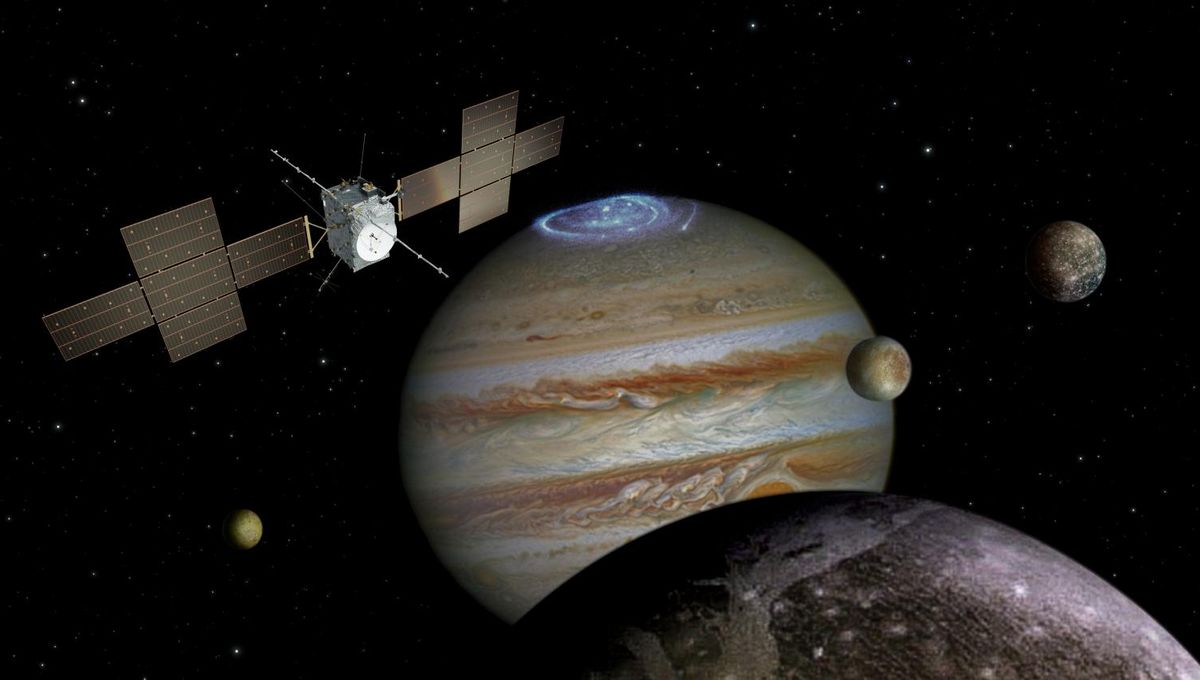
Get ready icy moons of Jupiter, Europe is coming for you. Today the first-ever European mission to Jupiter, JUICE, successfully launched from French Guiana, and is now on its peculiar flight towards the Jovian system. It will reach the gas giant in July 2031 and once there will provide new insights into its three large icy moons and how the planet interacts with them and the other orbiting bodies around it.
The European Space Agency (ESA) mission was originally scheduled for April 13, but due to lightning risk (ironic for a mission to Jupiter) was postponed to the day after due to the incredibly precise nature of this launch. The mission needed to launch within one second of its planned time, otherwise it wouldn’t gather enough speed to be free of our planet’s pull.
“The launch window is exceedingly narrow for missions of this kind, interplanetary trajectories, because they must exit the sphere of influence of Earth,” Ignacio Tanco, JUICE Spacecraft operation manager, told IFLScience.
“They must have an excess velocity that will allow the probe, in this case, to climb out of the gravity well of the Earth. So, if we were launching with a lower velocity, it would be captured and stay in orbit around Earth.”
But rocket power alone is not enough to get to Jupiter roughly 890 million kilometers (553.5 million miles) away, so JUICE will have to steal orbital energy from Venus and the Earth System with gravity-assist maneuvers to slingshot itself forward. In its eight-year voyage, JUICE will do a flyby of Venus once and Earth three times; the first one is a unique maneuver using both the Moon and Earth, and the last one will be in 2029, just two years before reaching Jupiter.
If all goes well, the spacecraft will also have the possibility of a flyby of an asteroid, potentially asteroid 223 Rosa in the main Asteroid Belt, before its first flyby of moon Ganymede, after which it will then enter into orbit around Jupiter. Then the science mission begins in earnest.
“It’s a very important mission because we want to find out whether there are habitable places inside the icy moons, so Europa, Ganymede, or Callisto. That’s the main question of the mission,” Dr Olivier Witasse, a planetary scientist working on the scientific aspects of the mission, told IFLScience.
There are many open questions about these three Galilean moons. Europa has an active surface, with fractures in its icy shell. Beneath there is a deep ocean possibly in contact with its rocky core. Callisto has the oldest surface in the Solar System but it might also hide an ocean under a much thicker icy crust. Ganymede, the mission’s main target, might be an in-between object, with an ocean with twice as much water as all Earth’s oceans, but not as close to the surface as Europa.
“Where is this ocean? Is it far from the surface? It’s important to know the thickness of the ice shell abode of the ocean and also how big is this ocean. What is the depth?” Dr Witasse said, sharing some of the pressing questions about the interior of Ganymede.
The spacecraft will fly past Europa twice, Ganymede 12 times, and past Callisto 21 times. After all its flybys, in December 2034 JUICE will enter into orbit around Ganymede and become the first spacecraft to orbit a moon other than our own. Ganymede is the biggest moon in the Solar System and the only one with a magnetic field. JUICE will dedicate the latter part of its primary mission, and perhaps its whole extended mission if fuel allows, to studying this curiosity
“The whole interior of the moon Ganymede will be studied with JUICE. So not only the ocean but also the ice layers. Because underneath the icy surface and the ocean, there might be another ice layer. And inside, in the middle of the moon, you have the iron core. It’s a core that we think is liquid and that generates its own magnetic field. That’s unique in the Solar System, to have a moon that generates its own magnetic field,” Dr Witasse told IFLScience.
The mission will collaborate with NASA’s Europa Clipper, which will focus on the smaller moon, as well as the other observatories that study Jupiter. Jupiter itself is an incredible target of exploration. The three icy moons plus the volcanic moon Io are very different from each other and JUICE will help us understand how they came to be. With 92 moons and counting, the Jovian system is like a miniature Solar System. With its observations, JUICE will give insights into our and other solar systems and may offer insights into what gas giant planets are like elsewhere in the universe.
All of this is what JUICE is hoping to tell us, but every mission ends up discovering things we weren’t expecting, so we’re sure to get a lot of surprises from this exciting mission, too.
Source Link: Exclusive: Europe Is Off To See If The Moons Of Jupiter Could Host Life